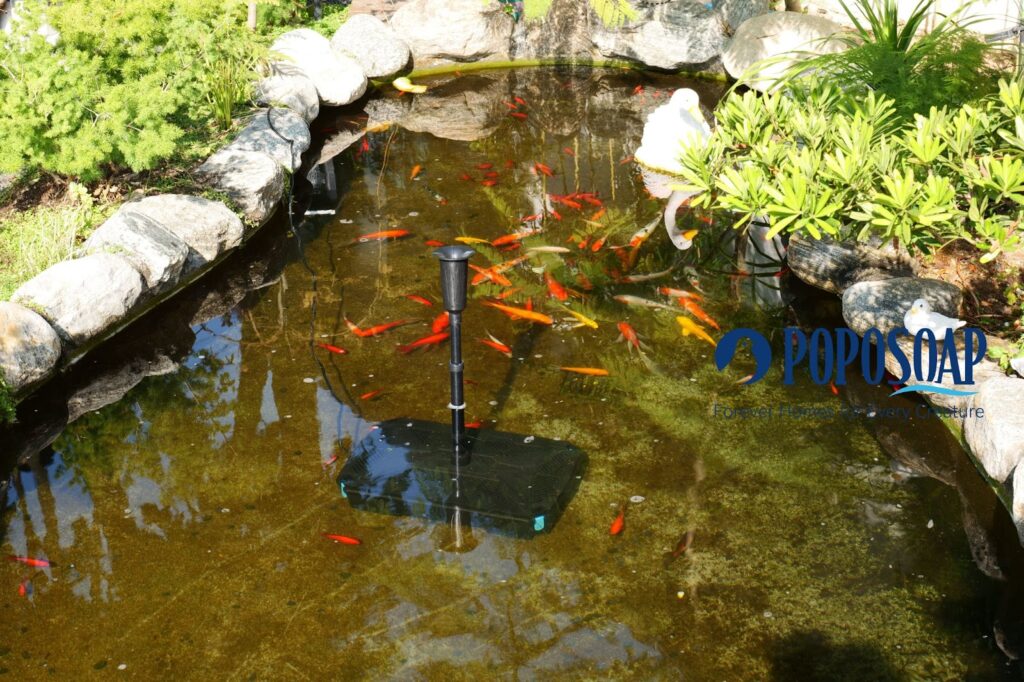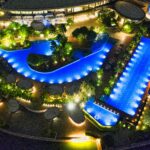Healthy koi are the highlight of a garden pond, but poor water quality, environmental stress, or pathogen infections can lead to fish illnesses. Timely identification and proper treatment of fish diseases are essential skills for every koi enthusiast. Additionally, prevention is better than cure—through a scientific water circulation and filtration system (such as the POPOSOAP Solar Water Pump Kit), the likelihood of fish diseases occurring can be effectively reduced. This article will introduce the identification and treatment methods of common koi diseases and focus on how a quality filtration system can create a healthy living environment for koi.
I. Identification and Treatment of Common Koi Diseases
Ichthyophthirius multifiliis (Ich)
Symptoms:
White spots on the body and fins (resembling salt grains)
Fish rubbing against the pond bottom or rocks frequently
Decreased appetite, rapid breathing
Cause: Infection by the parasite Ichthyophthirius multifiliis, common during sudden water temperature changes or deteriorating water quality.
Treatment:
Slowly raise the temperature to 28-30°C (increase by 1-2°C per day), maintain for a week
Use a specific Ich treatment
Increase aeration, enhance oxygen levels
Fin and Tail Rot Disease
Symptoms:
White or blood-red ulcers on the edges of the fins
Severe cases may lead to fin tearing and detachment
Cause: Bacterial infection (e.g., Flexibacter columnaris), often triggered by poor water quality or fish injuries.
Treatment:
Improve water quality, increase water change frequency
Use antibiotic medication (e.g., Tetracycline)
Add coarse salt (3‰ concentration) for auxiliary treatment
Anchor Worm Disease
Symptoms:
Long, slender worm bodies (about 1cm) visible on the fish’s body
Swollen, bleeding areas where the parasite resides
Fish behaving restlessly, jumping or rubbing against surfaces
Cause: Parasitic infection by anchor worms, often introduced through new fish or aquatic plants.
Treatment:
Manual removal of the worms (requires careful handling)
Use specialized parasiticidal agents like Dimilin
Disinfect the entire pond to prevent recurrence
Pine Cone Disease (Dropsy)
Symptoms:
Scales standing on end, resembling a pine cone
Body surface congestion, abdominal swelling
Cause: Bacterial infection (e.g., Pseudomonas), often associated with deteriorating water quality and significant temperature fluctuations.
Treatment:
Isolate diseased fish to prevent spread
Use antibiotics (e.g., Fluconazole)
Maintain stable water temperature, enhance filtration
II. Key to Preventing Fish Diseases: A Healthy Water Environment
90% of koi diseases are related to water quality issues. Maintaining a stable water environment is more critical than treatment. The three core elements of a healthy fish pond:
High-Quality Filtration System
Mechanical Filtration: Removes suspended solids
Biological Filtration: Cultivates nitrifying bacteria, decomposes harmful substances
Chemical Filtration (optional): Adsorbs toxins
Stable Water Flow and Aeration
Ensure adequate water circulation to prevent dead spots
Increase oxygen levels to inhibit anaerobic bacterial growth
Appropriate Water Temperature and pH
Optimal koi water temperature: 20-25°C
Maintain pH between 7.0-8.0 (slightly alkaline)
III. Protective Role of the POPOSOAP Solar Water Pump Kit
The POPOSOAP solar water fountain is specifically designed for koi ponds and significantly reduces the risk of fish diseases through the following functions:
Efficient Three-Level Filtration System
First Level: Mechanical filtration with high-density filter cotton traps feces, leftover feed, and large particles to keep the water clear.
Second Level: Biological filtration utilizing porous filter media provides a large surface area, cultivating nitrifying bacteria to continuously break down ammonia and nitrites.
Third Level: UV Sterilization (optional) uses ultraviolet light to kill free pathogens (like Ichthyophthirius multifiliis, bacteria), reducing disease transmission.
Intelligent Water Flow Control
Automatically adjusts pump power based on sunlight intensity to ensure stable water flow around the clock.
Multi-directional water outlet design eliminates dead spots, preventing the accumulation of pollutants.
Enhanced Oxygen Dissolution Technology
Waterfall or fountain-style water discharge naturally aerates, increasing oxygen levels.
Low-energy brushless motor runs continuously for 24 hours without interruption, preventing nighttime oxygen depletion.
Environmental Protection and Energy Efficiency Advantages
Solar-powered, zero electricity costs, suitable for long-term continuous operation.
No external power lines eliminate the risk of electric shock, ensuring the safety of the fish.
IV. Daily Maintenance Recommendations
Regularly test water quality: Test ammonia, nitrites, and pH weekly.
Feed scientifically: Avoid overfeeding; fish should consume food within 5 minutes.
Gradual water changes: Change no more than 1/3 of water each time to avoid sudden temperature fluctuations.
Quarterly deep cleaning: Rinse filter media, retain beneficial bacteria.
Conclusion
The health of koi directly reflects the level of water quality management. By identifying common diseases and implementing the comprehensive protection of the POPOSOAP Solar Water Pump Kit, your fish pond will maintain clarity and stability long-term, significantly reducing the occurrence of fish diseases. Remember: An efficient filtration system is worth more than ten emergency treatments!



